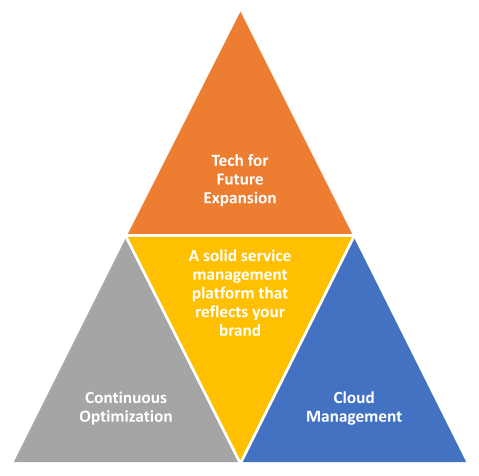Many businesses, including large enterprises, have traditionally reached out to managed services providers (MSPs) for help in managing their IT infrastructure, as this model allows for a myriad of emergent benefits. These benefits can range from the creation of new revenue opportunities for service providers to bringing in new tools and offering additional services, such as backup and recovery, application modernization, software management, infrastructure improvements, etc. As a bonus, this also appeals to System Integrators (SIs), who can supply technical manpower and resources to address new opportunities, and to manage and maintain both infrastructure and software. Recently, however, we have observed a new trend where SIs themselves now create business units to address the managed services space and, in some cases, transform into Managed Service Providers.
Learn How Your Customers Are Using Cloud Services
As new technologies emerge, notably the cloud and SaaS, we can see that customers become increasingly aware of the cloud as a platform, with which they can scale their business. Moving to SaaS applications also reduces their burden of managing software and its associated hardware, while focusing on their core line of business. To make this happen, service providers are brought in to consult on these new opportunities, which, in turn, allows for more business for their services. However, moving to the cloud and SaaS requires new expertise to be gained and different models to be established to support customers. Also, traditional MSPs and SIs, who were strong in IT operations for on-premises and datacenters, now need to grow their expertise to address the customer-driven trends, now towards the cloud.
Go to Market with Cloud Services More Quickly
The cloud services businesses of today require an update, as new tools, platforms, and services have emerged that allow for better efficiency and utility. These elements need to be assembled and delivered to customers at an expeditious rate to match the speed of progress that we can see with the newly emerging cloud trends. With this knowledge, it makes sense to acquire tools from other software vendors and make them available to customers as a service, following a SaaS-like model; this allows for service providers to distribute the aforementioned items of interest easily and quickly. Although, it is still necessary for teams to be trained in how to use these tools, such that they can provide the service provider with sufficient means by which they can effectively offer these services.
But why is it important for service providers to adopt this specific model? Well, the answer lies in the fact that customers find it more useful to conduct their business with newer companies who are specialized in their field of interest. Nowadays, traditional MSPs and SIs run the risk of losing their current customers to the newer services companies that specialize in Cloud technologies, hence, to ensure both better retention and growth of customer base, service providers can shift to a more SaaS-oriented model.
Address the New Cloud Marketplace Requirements
As the cloud continues to become a new medium to scale businesses, customers have started to demand cloud strategies from services companies before further plans can be made, leading to the move to cloud services becoming an essential step to be in line with such customers. Even though this is a necessary step for service providers to take, building services that address the needs of a customer moving to the cloud can be daunting without the right tools.
Such a task requires a strong service management platform on which you could add additional services, such as cloud management and continuous cloud optimization. Also, in assembling services that satisfy the customers’ needs with the cloud, it is vital to be cognizant of the fact that cloud technologies rapidly advance and the future expansions of additional new services must be integrated into the service delivery platform.

Create a New Revenue Stream for Your Managed Service Business
Now, with the service delivery platform completed, the service provider must focus on management, as there is as much a need to manage cloud resources as there is for IT resources, more specifically, for on-premises premises or for customers’ datacenters. For these management tasks, the tools required are new, and the training and expertise required are completely different from other facets of the cloud migration process. This allows for new revenue opportunities to rise for the teams once again with an entrepreneurial spirit willing to pursue them. Let us explore two simple service possibilities that existing Managed services companies can readily offer as services to customers:
1. Continuous Cloud Optimization
To start with, when companies start using the cloud, it generally gets out of control, as resources are being provisioned without management processes or procedures put in place. We have seen that, on average, about 30% of cloud costs can be recovered by paying attention to the usage of these resources and assigning governance mechanisms to control the cloud resource sprawl. The following are three simple mechanisms that can get customers started in realizing saving costs:
- Service providers offer cost optimization as a service to look for underutilized resources and assign them to a scaled-down version of a similar type of resource.
- Identify resources that are unused and delete them.
- Identify low-cost versions of the same resources such as spot instances or reserved resources that can save costs when the right criterion of its usage is met.
There is a myriad of tools available that can help in identifying the above-mentioned scenarios and executing the actions required to realize the cost savings with ease.
2. Cloud Management
Overall, continuous cloud management is necessary to set up governance and good practices around cloud usage. MSPs can offer the following capabilities as a service, which brings tremendous value to companies that are new to the cloud:
- Ensuring security of resources from external threats.
- Cost budgeting and alerts on cost overruns.
- Resource provisioning and deprovisioning with a clear workflow that conforms to process guidelines established by the company.
Using tools that are already available is a good start. There are several tool providers out there in the market that address one or more of such capabilities.
Add Cloud Optimization and Cloud Management as Your New Service Line
One of the primary criteria of choosing a platform is to find one that encapsulates sufficient capabilities to offer significant value for cloud optimization, as well as cloud management. As such, one of the leading platforms that can provide this is ComPaaS from Corent. ComPaaS has most of the capabilities discussed above, ideally suited for managed service providers and, as a platform, it can be provisioned instantly and branded to establish a unique identity for the MSP. This platform can also be adopted by SIs to create their own managed services businesses. Additionally, ComPaaS offers a single pane to access all the details of the cloud with immersive visualization, a feature not seen in other tools. It also integrates advisories along with actions to immediately execute them.
You can get started and offer continuous cloud optimization and management as-a-Service to your customers in 3 simple steps:
- Contact Corent with interest to offer this platform as your own, white-labeled service, to create your unique brand.
- Review a demonstration of this platform and discuss if you can go to market with this service.
- Provision yourself as a service provider and start offering ComPaaS as a service to your customers.


No Comments